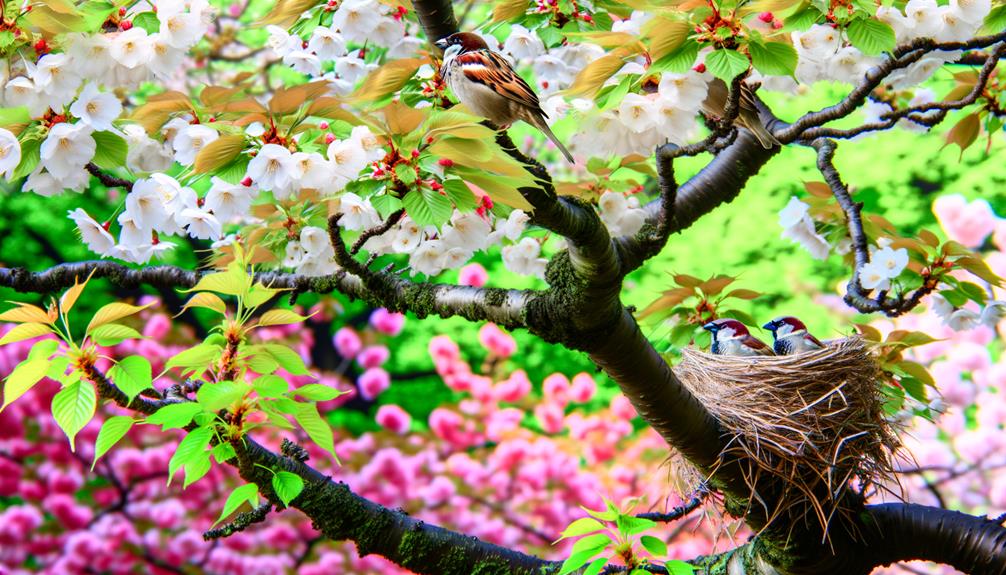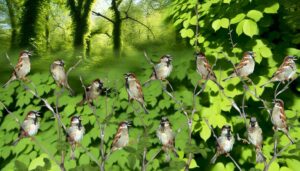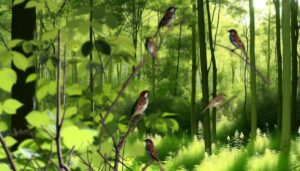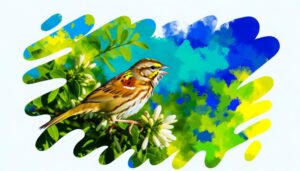How to Identify and Build a Home Called Sparrow Nest
A sparrow's home, known as a nest, is intricately constructed using twigs, grasses, and feathers. Sparrows show a preference for building their nests in tree branches, building eaves, dense shrubbery, and sometimes even ground levels.
They employ a combination of natural and man-made materials like leaves, feathers, and string for added stability and insulation. Nests are strategically hidden to protect against predators, using camouflage and alarm calls.
Both male and female sparrows play roles in nest building, with males often gathering materials while females focus on construction. Understanding their nesting habits reveals their adaptability in different environments.

Key Takeaways
- The home of a sparrow is called a nest.
- Sparrow nests are made from twigs, grass, feathers, and man-made materials.
- They build nests in tree branches, building eaves, and dense shrubbery.
- Sparrows use nests for reproduction and raising their young.
- Nest locations include ground, tree, cavity, and bush nests.
What Is a Sparrow's Home?
A sparrow's home, typically termed a nest, is meticulously constructed using twigs, grasses, and feathers to provide a secure environment for breeding and shelter. Sparrows exhibit remarkable precision when selecting materials, ensuring structural integrity and insulation. They often gather soft feathers and fine grass to create a comfortable lining, pivotal for egg incubation and chick development.
The nest's architecture reflects an intricate balance between sturdiness and comfort, safeguarding the inhabitants from predators and harsh weather conditions. These avian engineers demonstrate an innate ability to weave and assemble components, optimizing spatial placement to maximize protection.
Observing sparrow nests reveals a complex interplay of natural instincts and environmental adaptation, showcasing their biological ingenuity in habitat construction.
Types of Sparrow Nests
Sparrows typically nest in a variety of locations, including tree branches, building eaves, and dense shrubbery.
They construct their nests using common materials such as grass, twigs, leaves, and feathers, which provide insulation and camouflage.
Their nesting habits exhibit a preference for sites that offer protection from predators and environmental elements.
Typical Nesting Locations
Although various sparrow species exhibit diverse nesting behaviors, they typically construct their nests in well-concealed locations such as dense foliage, cavities, or man-made structures. Dense foliage provides ideal camouflage from predators, while cavities in trees or buildings offer protective enclosures. Urban sparrows often exploit human-made environments, nesting in crevices of buildings, gutters, or even under eaves.
House Sparrows (Passer domesticus) frequently select urban areas, utilizing any available nook. Tree Sparrows (Passer montanus), in contrast, prefer natural cavities in trees. The nesting site selection is influenced by factors such as predator presence, food availability, and environmental conditions.
Each species exhibits specific nesting preferences that enhance their survival and reproductive success, highlighting their adaptability to diverse habitats.
Common Nest Materials
Sparrow nests typically incorporate materials such as grasses, stems, leaves, feathers, and sometimes even paper or string, reflecting their adaptability to available resources. These avians exhibit remarkable ingenuity in selecting nesting materials, often using what's most accessible within their environment.
Grass stems form the structural base, ensuring stability, while leaves and feathers provide insulation. Feathers are particularly advantageous due to their lightweight and thermal properties. Notably, sparrows have been observed incorporating human-made materials like paper and string, which showcases their resourcefulness.
This blend of natural and synthetic components not only illustrates the sparrow's versatility but also highlights their interaction with urban environments. Their material choice demonstrates a keen ability to adapt to diverse ecological niches.
Nesting Habits Overview
When examining the nesting habits of sparrows, one finds that these birds construct a variety of nest types, each uniquely suited to their specific habitat and environmental conditions. Sparrows exhibit remarkable adaptability in their nesting strategies, which can be categorized as follows:
- Ground Nests: Typically found in open fields, these nests are shallow depressions lined with grass and feathers.
- Tree Nests: Built in branches, these nests are compact structures composed of twigs and leaves.
- Cavity Nests: Often located in tree holes or man-made structures, these nests use a mix of soft materials for insulation.
- Bush Nests: Constructed within dense shrubs, these nests offer protection from predators and harsh weather.
Each nest type reflects the sparrow's ability to thrive in diverse environments.
Nest Building Materials
To construct their nests, sparrows meticulously gather a diverse array of materials such as grasses, twigs, feathers, and even human-made debris. Each material serves a specific function in the nest's architecture, contributing to insulation, structural integrity, and camouflage. Sparrows demonstrate remarkable adaptability by incorporating available resources into their nesting strategies.
| Material | Function | Source |
|---|---|---|
| Grasses | Insulation | Natural environment |
| Twigs | Structural support | Trees and shrubs |
| Feathers | Cushioning | Other birds or self |
| Human-made debris | Reinforcement | Urban areas and waste |
Their selection process is not random; it reflects an evolved behavior aimed at optimizing the nest's durability and comfort. Observing these choices provides insight into sparrows' ecological adaptability and resourcefulness.
Location Preferences
By carefully selecting nesting sites, sparrows enhance the efficiency of their chosen materials and maximize protection for their offspring. They exhibit a preference for locations that offer both concealment and proximity to food sources.
Detailed observations indicate that sparrows favor:
- Thick Foliage: Nesting in dense shrubs or trees provides camouflage and protection from predators.
- Man-Made Structures: Eaves, gutters, and crevices in buildings offer sheltered spaces.
- Undergrowth: Ground nests are often hidden by tall grasses or low shrubs.
- Cliff Walls: Natural rock formations provide high, inaccessible locations.
These preferences ensure ideal thermal regulation, reduced predation risk, and ease of access to foraging areas.
Urban Vs. Rural Nests
In analyzing urban versus rural sparrow nests, notable differences in nesting materials arise, with urban sparrows frequently incorporating man-made debris.
Predation and safety factors also vary, as urban environments present fewer natural predators but increased risks from human activity.
Additionally, food availability notably impacts nesting success, with urban areas often providing more consistent but less varied food sources compared to rural settings.
Nesting Material Differences
Urban sparrows often incorporate synthetic materials such as plastic and paper into their nests, whereas their rural counterparts mainly use natural elements like grasses and twigs. This divergence in nesting materials can be attributed to the differing availability of resources in urban versus rural environments. Through systematic observation, one can identify key differences:
- Urban Nests:
- Synthetic fibers (e.g., plastic)
- Paper fragments
- Textile scraps
- Metal wires
- Rural Nests:
- Grass stems
- Twigs
- Feathers
- Animal fur
These variations indicate an adaptive behavior among sparrows to utilize available materials, demonstrating a resourceful approach to nest construction.
This adaptability highlights the species' resilience and ability to thrive in diverse habitats, providing insight into their ecological interactions and survival strategies.
Predators and Safety
The interplay between predator presence and nesting site safety reveals significant differences in the survival strategies of urban and rural sparrows. Urban sparrows benefit from reduced predator diversity, primarily facing domestic cats and occasional birds of prey. Their nests, often in buildings and structures, offer enhanced protection.
Conversely, rural sparrows contend with a broader range of predators, including snakes, hawks, and raccoons. Their nests, typically in trees or shrubs, require strategic placement to mitigate these threats. Observation indicates urban nests are closer to human activity, capitalizing on the predator-deterrent effect. Rural nests, isolated and concealed, rely on natural camouflage.
These contrasting environments necessitate adaptive behaviors, influencing sparrow nesting success and population dynamics.
Food Availability Impact
Sparrows exhibit distinct foraging patterns in urban and rural environments, notably influenced by the variability in food availability. Urban nests often benefit from diverse and consistent food sources due to human activity, leading to higher foraging efficiency. Conversely, rural nests depend on seasonal and natural food sources, which can be more erratic.
Key observations include:
- Food Source Diversity: Urban areas offer a wide variety of food due to human waste and bird feeders.
- Foraging Efficiency: Urban sparrows spend less time foraging compared to their rural counterparts.
- Seasonal Variability: Rural sparrows face noteworthy seasonal fluctuations in food supply.
- Diet Composition: Urban sparrows have a diet higher in processed foods, while rural sparrows consume more natural seeds and insects.
These factors impact sparrow health and reproductive success to a notable extent.
Nest Construction Process
Constructing their nests, sparrows meticulously gather materials like twigs, grasses, and feathers to create a sturdy and insulated home. They often choose locations offering shelter and concealment, such as tree branches, eaves of buildings, or even in crevices.
The process begins with the sparrows weaving a foundational structure from twigs, guaranteeing stability. Next, they line the interior with softer materials like grasses and feathers, enhancing insulation and comfort for their eggs and nestlings. This layering technique provides thermal regulation and protection against the elements.
Sparrows exhibit remarkable adaptability, sometimes incorporating man-made materials like string or paper. Their methodical approach secures the nest's durability and efficacy, ultimately supporting successful reproduction and offspring survival.
Role of Male Sparrows
Male sparrows actively participate in courtship displays and territory defense, guaranteeing the safety and attractiveness of their nesting site. Their roles are multifaceted and critical for reproductive success.
Scientific observations have documented these key male sparrow behaviors:
- Courtship Display: Males exhibit elaborate courtship rituals, involving song and physical displays, to attract potential mates.
- Territory Defense: Males aggressively defend their territory from intruders, using vocalizations and physical confrontations to maintain control.
- Nest Material Collection: Males contribute to nest construction by gathering and delivering materials such as twigs and grass.
- Feeding the Mate: During the breeding season, males often feed the female to strengthen pair bonds and guarantee she remains healthy.
This methodical approach to their roles guarantees the successful establishment and maintenance of the nest.
Role of Female Sparrows
Female sparrows play a vital role in the reproductive process. They primarily focus on selecting suitable nesting sites and incubating eggs. They exhibit careful behavior when choosing a location, often preferring cavities or dense foliage to ensure the best protection.
Once a site is selected, the female sparrow constructs the nest using grass, feathers, and small twigs. This creates a stable and insulated environment. During incubation, which lasts approximately 11-14 days, the female maintains constant vigilance. She regulates egg temperature to promote proper embryonic development.
This period demands significant energy and dedication. The female sparrow rarely leaves the nest, relying on the male for food provisioning. Her role is crucial for the survival and well-being of the offspring, emphasizing her significance in sparrow reproductive success.
Nest Protection Mechanisms
In addition to selecting and constructing nesting sites, sparrows employ various strategies to protect their nests from predators and environmental hazards. Their methods are both instinctual and adaptive, ensuring the survival of their offspring.
Detailed observations reveal the following mechanisms:
- Camouflage: Sparrows use materials that blend with their surroundings, making nests less visible to predators.
- Nest Placement: They often build nests in high or concealed locations, reducing accessibility for ground-based threats.
- Aggressive Defense: Adult sparrows exhibit aggressive behavior towards intruders, effectively deterring potential nest raiders.
- Alarm Calls: They produce specific alarm calls to alert other sparrows of dangers, thereby increasing communal vigilance.
Such strategies demonstrate the sparrow's intricate methods for ensuring nest security.
Seasonal Nesting Habits
Sparrows exhibit distinct seasonal nesting habits, influenced by their preferred nesting locations and migratory patterns. During spring and summer, they mostly select urban and suburban areas, utilizing cavities in buildings and dense vegetation.
Their migratory behavior greatly impacts nesting, with some species adjusting their nesting sites based on geographical and climatic changes.
Preferred Nesting Locations
Throughout the year, house sparrows exhibit a marked preference for nesting in human-made structures, adapting their nesting habits to different seasonal conditions. They seek environments that provide shelter and proximity to food sources.
Detailed observations indicate several preferred nesting locations:
- Eaves and Roofs: Sparrows often nest in crevices and gaps under eaves and roofs, offering protection from predators and weather.
- Building Ledges: The ledges of buildings provide a stable, elevated nesting site, away from ground disturbances.
- Streetlamps and Traffic Lights: These structures offer warmth and a vantage point for foraging.
- Vents and Air Conditioners: The birds frequently choose these spots for the warmth emitted, which is vital during colder months.
This methodical analysis underscores their adaptability and reliance on human environments.
Migration and Nesting
As seasons change, house sparrows modify their nesting behaviors to accommodate varying environmental conditions and resource availability. During spring, they exhibit increased nest-building activity, choosing sheltered locations to protect their offspring from temperature fluctuations.
Observations indicate a preference for urban structures, where food and nesting materials are abundant. In summer, sparrows often reuse nests, optimizing energy expenditure. Their nesting material selection shifts towards finer elements, like feathers, to enhance thermal regulation.
Autumn sees a decline in nesting activity as they prepare for winter, focusing on foraging. House sparrows in temperate regions might exhibit partial migration to areas with milder climates. Their adaptive nesting strategies underscore their resilience and ability to thrive in diverse habitats.
Importance of Nesting Sites
A well-built nesting site significantly enhances a sparrow's chances of successful reproduction and survival in various environments. Such sites provide critical resources and protection against predators and harsh weather conditions.
Detailed observations highlight four key factors:
- Location: Nesting sites in sheltered areas reduce the risk of predation and environmental stress.
- Materials: Sparrows use grass, feathers, and twigs, which offer insulation and camouflage.
- Structure: A strong nest architecture guarantees stability and safety for eggs and hatchlings.
- Proximity to Resources: Access to food and water sources nearby supports the nourishment of both adults and chicks.
These factors underscore the systematic analysis required to understand sparrows' nesting preferences, ensuring their ongoing survival and reproductive success.
Human Impact on Nests
Human activities alter sparrows' nesting environments to a great extent, often leading to habitat destruction and increased competition for limited resources. Urban development eradicates natural nesting sites, substituting them with structures unsuitable for nest-building.
Pollution contaminates materials sparrows use, impacting nest durability and chick survival rates. Additionally, invasive species introduced by humans outcompete sparrows for both food and nesting sites.
Agricultural practices, particularly pesticide use, reduce insect populations, depriving sparrows of their primary food source during breeding seasons. Light pollution disrupts circadian rhythms, affecting breeding cycles and nestling development.
Conservation efforts must address these multifaceted impacts through habitat restoration, pollution control, and regulations on pesticide usage to mitigate human-induced threats to sparrows' nesting success.
Conclusion
Ultimately, a sparrow's home, often termed a nest, is a marvel of avian engineering. These nests, varying from intricately woven grasses to urban crevices, embody careful craftsmanship.
Located in trees, shrubs, or man-made structures, they reflect sparrows' adaptability. Seasonal behaviors, such as selecting specific materials and sites, guarantee ideal protection.
Human activities, however, pose risks to these essential habitats. Hence, preserving sparrow nesting sites is critical for their survival and ecological balance.





